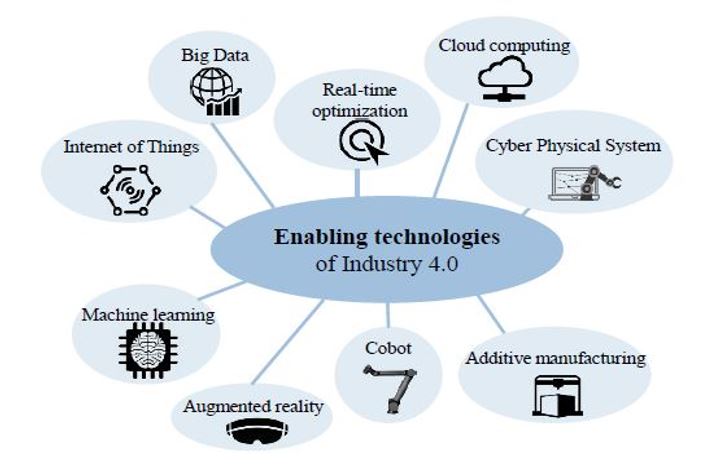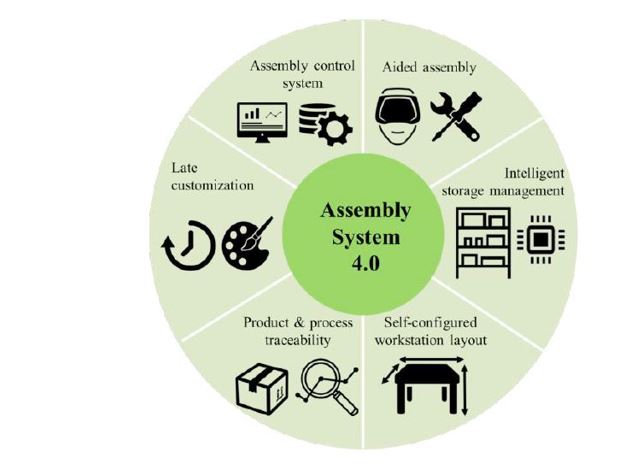TQM and industry 4.0

Industry 4.0 refers to the fourth industrialized revolution. The aim of this section is to highlight the role of industry 4.0 in developing Total quality management practices.
Illustration of Industry 4.0, showing the fourth “industrial revolution”

- The first revolution: The first revolution started during the 18th century, steam and water were the first source of power during this period.
- The second revolution: This wave appeared during the 20th century and was based on mass production; increasing production is achieved thanks to repeated tasks and labour experience from repeated work in order to answer market demand. This period was characterized by using conveyors to transfer products between machines automatically.
- The third revolution: It consists of integrating the programmable logic controllers (PLC), invented during the 1970s. This invention created automation of industrial processes, and reduced labour work.
- The fourth revolution: Recently, the computer systems were developed and integrated in the industry, this utilization was developed until IOT was brought to stage and launched the new fourth industrial revolution which was agreed to be known as the Industry 4.0, (Brettel et al. (2014), MacDougall (2013), Qin et al. (2016)). Kagermann et al. (2011) stated that Industry 4.0 first appeared at the Hannover Fair. It is considered by the German government as part of the “High-Tech Strategy 2020 Action Plan” to identify the fourth industrial revolution. Industry 4.0 is the automation of traditional manufacturing and industrial practices, using IT and smart technologies. Internet of things, machine to machine communication (M2M) are widely used to support automation, improve communication and self-inspection, and systems that can analyse and diagnose issues without the need for human intervention, Davis (2015). According to Klaus Schwab executive chairman of the World Economic Forum 2015, this fourth era combines software, hardware and biology. It is characterized by improvement in communication and connectivity. This era witnesses an advancement in emerging technologies like robotics, artificial intelligence, nanotechnology, biotechnology, quantum computing, internet of things, 3D printing, etc. Germany is a pioneer in Industry 4.0. This transformation is led by German companies (Bosch). Automation is improved by the introduction of self-optimization, self-configuration, self-diagnosis, and support of employees in order to better handle this transformation.
Industry 4.0 key factors have been discussed in different studies, (Michael and Subhash (2020), Sanjiv et al. (2020), Samaranayake et al. (2017)). In this regard, Michael and Subhash (2020) identified different factors for readiness of organisations to implement industry 4.0; these factors are top management commitment and involvement, employee adaptability with industry 4.0, smart product and services, extent of digitization of supply chain, level of digitization of the organisation, and readiness of for organisational strategy.
Sanjiv et al. (2020) highlighted in their study multiple factors for the adoption of I4.0 based on an extensive literature review and series of interviews. They concluded that leadership, strategy and culture are key elements for the adoption of I4.0; moreover, digital win, virtual testing and simulation are important factors for the manufacturing sector. Moreover, Samaranayake et al. (2017) conducted a study on different I4.0 readiness factors. Their findings reveal that flexibility in production/service and stability of the process are important factors for I4.0 implementation. Samaranayake et al. (2017) presented as well six dimensions for I4.0 readiness.
Bortolini et al. (2017) provided in their study different I4.0 enablers ;
we summarised below Bortolini et al. (2017) list of I4.0 enablers:
- Internet of things (IoT): in industry objects and several things can communicate with each other for a common purpose.
- Big data: the communication between different object generates a huge amount of data. Different challenges are faced to store this data, to analyse. Data should be accessible fast for a better use.
- Cloud computing: is a method of storage of big dataset with different benefits like easy accessibility.
- Cyber physical system: data are collected from different sensors; this data is collected into a central hub and analysed later to support the decision process.
- Machine learning: preventive decisions and self-configurable devices benefit from machine learning. Clusters of computer algorithms are able to learn and execute tasks.
- Cobots: are a new generation of robots; they are able to cooperate with humans’ operators and to interact with them.
- Augmented reality: this technology improves the surrounding environment of human operators offering interaction with virtual objects.
- Additive manufacturing: is the process of making objects from 3D models, adding proper material layer after layer. This method minimise waste, able to manufacture complex shapes and supports on-demand production.
Enabling technologies of industry 4.0. Source: Bortolini et al. (2017).

- Aided assembly: when a product reaches a workstation, light picking automatically show the components to pick up from the station, augmented reality shows the action to undertake. This reduces the risk of mistakes during assembly.
- Intelligent storage assembly: sensorized storage locations send information about inventory and send refilling requests automatically; this achieves enormous saving and avoids shortages in production line.
- Self-configured workstation layout: depending on the task in the workstation, the workbench, the rack, and the shelf dimensions are adjusted.
- Product and process traceability: all assembly tasks are tracked to detect any possible error or non-compliance. Equipment are sensorized all the valuable data stored in the cloud for later analysis.
- Late customization: late customisation in assembly line 4.0 products are customised according to customer needs; customers also can intervene in different stages of production. Therefore, the assembly line is characterised by a huge flexibility.
Main characteristics of Assembly line 4.0. Source: Bortolini et al. (2017).


